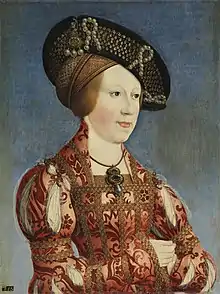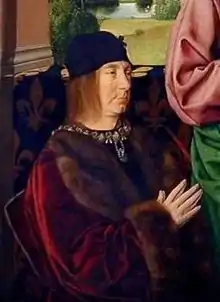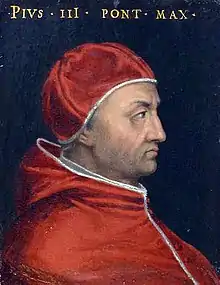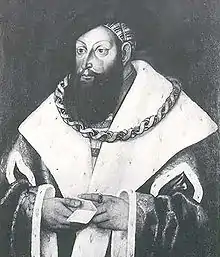1503
Year 1503 (MDIII) was a common year starting on Sunday (link will display the full calendar) of the Julian calendar.
| Millennium: | 2nd millennium |
|---|---|
| Centuries: | |
| Decades: | |
| Years: |
| 1503 by topic |
|---|
| Arts and science |
| Leaders |
|
| Birth and death categories |
| Births – Deaths |
| Establishments and disestablishments categories |
| Establishments – Disestablishments |
| Works category |
|
| Gregorian calendar | 1503 MDIII |
| Ab urbe condita | 2256 |
| Armenian calendar | 952 ԹՎ ՋԾԲ |
| Assyrian calendar | 6253 |
| Balinese saka calendar | 1424–1425 |
| Bengali calendar | 910 |
| Berber calendar | 2453 |
| English Regnal year | 18 Hen. 7 – 19 Hen. 7 |
| Buddhist calendar | 2047 |
| Burmese calendar | 865 |
| Byzantine calendar | 7011–7012 |
| Chinese calendar | 壬戌年 (Water Dog) 4199 or 4139 — to — 癸亥年 (Water Pig) 4200 or 4140 |
| Coptic calendar | 1219–1220 |
| Discordian calendar | 2669 |
| Ethiopian calendar | 1495–1496 |
| Hebrew calendar | 5263–5264 |
| Hindu calendars | |
| - Vikram Samvat | 1559–1560 |
| - Shaka Samvat | 1424–1425 |
| - Kali Yuga | 4603–4604 |
| Holocene calendar | 11503 |
| Igbo calendar | 503–504 |
| Iranian calendar | 881–882 |
| Islamic calendar | 908–909 |
| Japanese calendar | Bunki 3 (文亀3年) |
| Javanese calendar | 1420–1421 |
| Julian calendar | 1503 MDIII |
| Korean calendar | 3836 |
| Minguo calendar | 409 before ROC 民前409年 |
| Nanakshahi calendar | 35 |
| Thai solar calendar | 2045–2046 |
| Tibetan calendar | 阳水狗年 (male Water-Dog) 1629 or 1248 or 476 — to — 阴水猪年 (female Water-Pig) 1630 or 1249 or 477 |
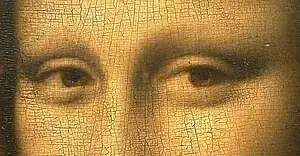
Work on Mona Lisa begins.
Events

January–March
- January 20 – Seville in Castile is awarded exclusive rights to trade with the New World.[1]
- January 24 – Construction of the Henry VII Chapel at Westminster Abbey begins in the perpendicular style, the final stage of English Gothic art.[2]
- February 13 – Challenge of Barletta: Thirteen Italian knights defeat thirteen French knights, near Barletta.[3]
- February 23 – French–Spanish Wars in Italy – Battle of Ruvo: The Spanish defeat the French.[4]
- March 15 – Portuguese explorer Vasco da Gama and sailors of his Portuguese India Armada become the first Europeans to sight the Seychelles islands as Thomé Lopes notes the discovery of what will later be called Silhouette Island.
April–June
- April 2 – The Kingdom of Cochin (ruled by a Portuguese-installed raja, Unni Ramman Koyil II in what is now part of India's Kerala state) is invaded by 50,000 Nair troops of the Zamorin of Calicut.[5]
- April 21
- Battle of Seminara: Spanish forces under Fernando de Andrade de las Mariñas defeat the French under Bernard Stewart, 4th Lord of Aubigny.[6]
- Battle of Cerignola: Spanish forces under Gonzalo Fernández de Córdoba defeat the French under Louis d'Armagnac, Duke of Nemours, who is killed (considered to be the first battle in history won by gunpowder small arms).[7]
- May 10 – Christopher Columbus discovers the Cayman Islands, which he names Las Tortugas, after the numerous sea turtles there.[8]
- May 13 – Naples is captured by the Spanish.
- May 20 (Feast of the Ascension) – Ascension Island is first definitively sighted, by Portuguese admiral Afonso de Albuquerque.[9]
- May 24 – The coronation of Moctezuma II as ruler of the Aztec Empire takes place at the Aztec capital of Tenochtitlan, now part of Mexico City. [10]
- May 28 – James IV of Scotland and Margaret Tudor are married as per the Treaty of Perpetual Peace by Pope Alexander VI, according to Papal bull.
- June 21 – Murad, the last Sultan of Aq Qoyunlu in what is now eastern Turkey fights the Safavid King of Persia, Ismail I in a battle near the city of Hamadan, and suffers 10,000 casualties, including his commander Güzel Ahmad.[11]
- June 23 – Representatives of King Henry VII of England and Queen Isabella of Spain sign a treaty for 12-year-old Henry, Prince of Wales to be married to Catherine of Aragon, widow of King Henry's son Arthur. [12]
- June 25 – After his ships are damaged in a storm, Christopher Columbus and his 230 men are forced to beach at the island of Jamaica (at what is now Saint Ann Parish) and remain stranded there for the next six months. [13]
- June 27 – The book The Imitation of Christ by Thomas à Kempis is re-published in an English translation.[14]
July–September
- July 23 – Orbital calculations suggest that on this day, Pluto moved outside Neptune's orbit, remaining there for 233 years.
- July 30 – Saint Helena is first definitively sighted, by ships of Portuguese navigator Estêvão da Gama returning from the East.[15][16][17]
- August 8 – King James IV of Scotland marries Margaret Tudor, daughter of King Henry VII of England, at Holyrood Abbey, Edinburgh, Scotland.[18]
- August 18 – Pope Alexander VI dies after a reign of 11 years, and the largest gathering of cardinals up to that time— 21 from Italy, 11 from Spain and 7 from France— is called to Rome for a papal conclave, to start in September.
- August 20 – A previous treaty between Vladislaus II of Hungary and Bayezid II, which was finalized on June 11th, goes into effect.[19] The treaty suppresses warfare along the Hungarian-Ottoman border. Stephen III of Moldavia is also included in this treaty, but it perserves his nation's independence on the condition Moldavia pays an annual tribute to the Ottoman Empire.
- September 22 – Francesco Todeschini Piccolomini, Archbishop of Siena, is elected as the new Pope after the voting cardinals cannot decide between Georges d'Amboise of France or Giuliano della Rovere of Italy. Piccolomini takes the name of Pope Pius III but will reign for only 26 days. [20]
October–December
- October 1 – Fort Emmanuel is christened at Cochin after Afonso de Albuquerque obtained permission to be able to build it.[21] It is the first European fort in India, in addition to being the first Portuguese fort.
- October 18 – Pope Pius III dies less than four weeks after being elected, prompting the calling of the second papal conclave in as many months.[22]: 198–207
- October 30 – Queen Isabella I of Spain issues an edict prohibiting violence against indigenous peoples in the New World.
- November 1 – Cardinal Giuliano della Rovere, Bishop of Ostia, is elected the 216th Roman Catholic Pontiff at the end of the year's second papal conclave and takes the papal name Pope Julius II.[22]: 210 Della Rovere had received 15 of 32 votes in the September voting for a plurality, but still short of a majority.[23]: 89 Julius II reigns for a little more than nine years until his death his death in 1513.[23]: 91
- November 11 – Bernard Stewart, 4th Lord of Aubigny, commander of the defeated French forces and a prisoner of war since his April 21 defeat at the Battle of Seminara, is released from Castel Nuovo in Naples after a truce between France and Spain.[24]
- November 29 – Pope Julius II, formerly Giuliano della Rovere, adds four new people to the College of Cardinals, including two members of his family, Clemente della Rovere and Galeotto della Rovere.[22]: 219 By the time of his death, Julius will have added 27 cardinals to the Roman Catholic Church, five of them from the della Rovere family.[25]
- December 29 – The Battle of Garigliano takes place near Gaeta in Italy. Spanish forces under Gonzalo Fernández de Córdoba defeat a French–Italian mercenary army under Ludovico II, Marquess of Saluzzo; the French forces, who suffer 4,000 casualties, withdraw to Gaeta.
Date unknown
- Mariotto Albertinelli paints The Visitation.[26]
- Hieronymus Bosch works on the triptych The Garden of Earthly Delights, although other sources suggest a 1490-1510 date range for when he worked on it.[27]
- Leonardo da Vinci probably starts work on painting the Mona Lisa in Florence.[28]
- From this year until 1660, sixteen million kilograms of silver and 185,000 kilograms of gold will enter the port of Seville.[29]
Births

Queen Isabella of Portugal
- January 3 – Al-Mutahhar, Imam of the Zaidi state of Yemen (d. 1572)
- January 11 – Parmigianino (Girolamo Francesco Maria Mazzola), Italian artist (d. 1540)[30]
- January 18 – Joachim of Münsterberg-Oels, Duke of Münsterberg, Duke of Oels, Count of Kladsko, Bishop of Brandenburg (d. 1562)[31]
- February 24 – Johann Gropper, German Catholic cardinal (d. 1559)[32]
- March 10 – Ferdinand I, Holy Roman Emperor (d. 1564)[33]
- March 11 – George Harper, English politician (d. 1558)[34]
- March 22 – Antonio Francesco Grazzini, Italian writer (d. 1584)[35]
- April 6 – Jacob Micyllus, German humanist (d. 1558)[36]
- April 18 – Henry II of Navarre, King of Navarre (1517–1555) (d. 1555)[37]
- May 1 – Celio Secondo Curione, Italian humanist (d. 1569)[38]
- June 1 – Wilhelm von Grumbach, German adventurer (d. 1567)[39]
- June 28 – Giovanni della Casa, Italian poet (d. 1556)[40]
- June 30 – John Frederick I, Elector of Saxony (d. 1554)[41]
- July 23 – Anne of Bohemia and Hungary, Queen consort of the Romans, Bohemia and Hungary (d. 1547)[42]
- August 12 – Christian III of Denmark and Norway (d. 1559)[43]
- September 10 – Elisabeth of Hesse, Countess Palatine of Zweibrücken, later Countess Palatine of Simmern (d. 1563)[44]
- October 4 – Isabella of Portugal, Queen of Spain (d. 1539)[45]
- November 12 – Philip, Duke of Palatinate-Neuburg, German duke (d. 1548)[46]
- November 13 – Ippolita Gonzaga, Italian nun (d. 1570)
- November 17 – Agnolo di Cosimo, Italian artist and poet (d. 1572)[47]
- November 19 – Pier Luigi Farnese, Duke of Parma (d. 1547)[48]
- December 14 – Michel de Nostredame, called Nostradamus, French physician and writer of Les Propheties (1555) (d. 1566)[49]
- December 20 – Cosimo Bartoli, Italian diplomat and writer (d. 1572)[50]
- date unknown
- Lucas David, Prussian historian (d. 1583)[51]
- Robert Estienne, French printer (d. 1559)[52]
- John Frith, English Protestant priest and martyr (d. 1533)[53]
- Susannah Hornebolt, English artist (d. c. 1554)[54]
- Lakandula, Lakan of Tondo (d. 1589)
- Shimazu Katsuhisa, Japanese nobleman (d. 1573)[55][56]
- Tomé de Sousa, Portuguese nobleman, first general-governor of Brazil (d.1573 or 1579)[57]
- probable – Nicholas Bourbon, French poet[58]
Deaths
- January 20 – Ludmila of Poděbrady, Regent of the duchies of Brzeg and Oława (1488–1503) (b. 1456)[59]
- February 11 – Elizabeth of York, queen of Henry VII of England (b. 1466)[60]
- February 23 – Annamacharya, Indian mystic saint composer (b. 1408)[61]
- March 14 – Frederick Jagiellon, Primate of Poland (b. 1468)[62]
- March 16 – Edward Story, Bishop of Carlisle and Chichester[63]
- April 7 – Sophia Palaiologina, Byzantine princess and Grand Princess of Moscow (b. 1449)[64]
- May 20 – Lorenzo di Pierfrancesco de' Medici, Italian patron of the arts (b. 1463)[65]
- June 2 – Clara Gonzaga, Italian noble (b. 1464)[66]
- July 3 – Pierre d'Aubusson, Grand Master of the Knights of Rhodes (b. 1423)[67]
- July 12 – Sophie of Mecklenburg, Duchess of Mecklenburg, Duchess of Saxony (b. 1481)[68]
- July 24 – Louise of Savoy, Nun (b. 1461)[69]
- August 5 – Reginald Bray, British courtier (b. 1440)[70]
- August 12 – Anna Jagiellon, Duchess of Pomerania, Polish princess (b. 1476)[71]
- August 18 – Pope Alexander VI (b. 1431)[72]
- September 5 – Margaret of Hanau-Münzenberg, German noblewoman (b. 1471)[73]
- October 10 – Peter II, Duke of Bourbon (b. 1438)[74]
- October 18 – Pope Pius III (b. c. 1439)[75]
- November 17 &ndash Bona of Savoy, Duchess of Savoy (b. 1449)[76]
- November 23 – Margaret of York, Duchess consort of Burgundy, spouse of Charles I, Duke of Burgundy (b. 1446)[77]
- December 1 – George, Duke of Bavaria (b. 1455)[78]
- December 14 – Sten Sture the Elder, regent of Sweden (1470–1497 and 1501–1503) (b. 1440)[79]
- December 28 – Piero di Lorenzo de' Medici, exiled ruler of Florence (drowned) (b. 1472)[80]
- date unknown
- Richard Amerike, English merchant and patron of John Cabot (b. 1445)[81]
- Anacaona, Taino queen and poet (b. 1474)[82]
References
- Cervantes, Fernando (September 14, 2021). Conquistadores: A New History of Spanish Discovery and Conquest. Penguin. p. 64. ISBN 978-1-101-98126-9. Retrieved June 18, 2023.
- Palmer, Alan; Veronica (1992). The Chronology of British History. London: Century Ltd. pp. 137–140. ISBN 0-7126-5616-2.
- Historia del combattimento de' tredici Italiani con altrettanti Francesi, fatto in Puglia tra Andria e Quarati (in Italian). Naples: Gabriele Porcelli. 1844. p. 5. Retrieved June 18, 2023.
- Prescott, William Hickling (1859). History of the reign of Ferdinand and Isabella, the Catholic. Boston: Phillips, Sampson, & Co. pp. 56–57. Retrieved June 19, 2023.
- Menon, T. Madhava (2000). A Handbook of Kerala. International School of Dravidian Linguistics. p. 151. ISBN 978-81-85692-27-2. Retrieved June 19, 2023.
- Almirante, José (1923). Bosquejo de la historia militar de España: hasta fines del siglo XVIII (in Spanish). Vol. 1. Sucesores de Rivadeneyra. Retrieved June 19, 2023.
- Hans Delbrück (1985). History of the art of war within the framework of political history. Greenwood Press. p. 73. ISBN 978-0-8371-6365-9.
- "Our History". Cayman Islands Government. Retrieved June 19, 2023.
- "Ascension History". Mysterra Magazine. Archived from the original on June 13, 2017. Retrieved December 9, 2011.
- "Account of Fernando de Alva Ixtlilxóchitl", in Obras históricas, Volume 2, ed. by Alfredo Chavero (Oficina de la Secretaría de Fomento Mexicano)
- Sarwar, Ghulam (1939). History of Shah Isma'il Safawi. Aligarh. p. 45. Retrieved June 19, 2023.
{{cite book}}: CS1 maint: location missing publisher (link) - J. J. Scarisbrick, Henry VIII (Yale University Press, 1997) p. 8
- Lawrence Bergreen, Columbus: The Four Voyages, 1493–1504 (Penguin, 2011) pp.330-332
- Creasy, William C. (September 15, 2015). The Imitation of Christ: A New Reading of the 1441 Latin Autograph Manuscript. Mercer University Press. p. xxii. ISBN 978-0-88146-097-1. Retrieved June 20, 2023.
- Schulenburg, A. H. (Spring 2002). "The discovery of St Helena: the search continues". Wirebird: The Journal of the Friends of St Helena. 24: 13–19.
- Leite, Duarte (1960). História dos Descobrimentos. Vol. II. Lisbon: Edições Cosmos. p. 206.
- da Montalboddo, Fracanzio (1507). Paesi Nuovamente Retovati & Nuovo Mondo da Alberico Vesputio Fiorentino Intitulato. Venice.
- Ring, Morgan (April 25, 2017). So High a Blood: The Story of Margaret Douglas, the Tudor That Time Forgot. Bloomsbury Publishing USA. ISBN 978-1-63286-607-3. Retrieved June 19, 2023.
On 8 August 1503, Margaret was led to the abbey church of Holyrood, a Gothic monastery that James had transformed into a palace. Sitting at the base of Arthur's seat, Holyrood offered Margaret new apartments, extensive gardens and respite from the noise of the city. There, she and James were married and Margaret was crowned.
- Pálosfalvi, Tamás (September 20, 2018). From Nicopolis to Mohács: A History of Ottoman-Hungarian Warfare, 1389-1526. Brill. p. 321. ISBN 978-90-04-37565-9. Retrieved June 19, 2023.
- Frieda, Leonie (2013). The deadly sisterhood : a story of women, power and intrigue in the Italian Renaissance, 1427-1527 (Paperback ed.). London: Phoenix. pp. 275–276. ISBN 978-0-7538-2844-1.
- Logan, William (1887). Malabar Manual, Vol. 1. Madras: Madras Government Press. pp. 309–310. ISBN 978-81-206-0446-9. Retrieved June 20, 2023.
- Pastor, Ludwig; Antrobus, Frederick Ignatius (1902). The History Of The Popes, From The Close Of The Middle Ages, Drawn From The Secret Archives Of The Vatican And Other Original Sources, Volume 6. St. Louis: B. Herder. Retrieved June 19, 2023.
- Baumgartner, Frederic J. (2003). Behind locked doors : a history of the Papal elections. New York: Palgrave Macmillan. ISBN 978-0-312-29463-2. Retrieved June 19, 2023.
- Cust, Lady Elizabeth (1891). Some Account of the Stuarts of Aubigny, in France: 1422-1672. Chiswick Press. p. 37. Retrieved June 20, 2023.
- "The Cardinals of the Holy Roman Church - Cardinals of the 16th Century". cardinals.fiu.edu. Retrieved June 20, 2023.
- "Watercolour - Copy after The Visitation (The meeting of Mary and Elizabeth), Mariotto Albertinelli in the Uffizi (Florence)". m.vam.ac.uk. 1869. Retrieved May 6, 2018.
- "Jardín de las delicias, El [El Bosco]". www.museodelprado.es. Retrieved June 20, 2023.
- Smith, Webster (June 1985). "Observations on the Mona Lisa Landscape". The Art Bulletin. 67 (2): 183–199. doi:10.1080/00043079.1985.10788256. ISSN 0004-3079. Retrieved June 20, 2023.
- Elliott, John Huxtable (1963). Imperial Spain, 1469-1716. New York: New American Library. p. 180. Retrieved June 20, 2023.
- Vasari, Giorgio (1848). Le vite de' più eccellenti pittori, scultori ed architetti: 2,1 (in Italian). Batelli. p. 487. Retrieved June 20, 2023.
- Hartmann, Franz (1907). Geschichte der Stadt Münsterberg in Schlesien von ihrer Gründung bis zur Gegenwart (in German). Münsterberger zeitung. p. 131. Retrieved June 20, 2023.
- Gulik, Wilhelm van (1906). Johannes Gropper (1503 bis 1559).: Ein beitrag zur kirchengeschichte Deutschlands, besonders der Rheinlande im 16. jahrhundert (in German). Herder. p. 1. Retrieved June 20, 2023.
- "Ferdinand I - Holy Roman emperor". Encyclopedia Britannica. Retrieved May 6, 2018.
- "HARPER, George (1503-58)". www.historyofparliamentonline.org. Retrieved June 20, 2023.
- "GRAZZINI, Anton Francesco". www.treccani.it (in Italian). Retrieved June 20, 2023.
- Classen, Johannes (1859). Jacob Micyllus (in German). Verlag f. Kunst u. Wissenschaft. p. 1. Retrieved June 20, 2023.
- Burgo, Jaime ignacio del (January 21, 2018). "Bajo el chantaje de la Justicia Francesa". Navarra en la Historia (in Spanish). Editorial Almuzara. ISBN 978-84-17229-92-4. Retrieved June 20, 2023.
On April 25, 1503, the infant Enrique was born in Sangüesa, who carried the title of Prince of Viana until the death of Queen Catalina (1517).
- Mainwaringe, Thomas; Curione, Celio Secondo (2007). Caelius Secundus Curio: His Historie of the Warr of Malta : Folger Ms. V.a. 508 (formerly Ms. Add. 588). Arizona Center for Medieval and Renaissance Studies. p. 19. ISBN 978-0-86698-387-7. Retrieved June 20, 2023.
- Ortloff, Friedrich (1868). Geschichte der grumbachischen händel (in German). F. Frommann. p. 4. Retrieved June 20, 2023.
- "DELLA CASA, Giovanni". www.treccani.it (in Italian). Retrieved June 20, 2023.
- Mentz, Georg (1903). Johann Friedrich der Grossmütige 1503-1554: Festschrift zum 400jährigen Geburtstage des Kurfürsten, namens des Vereins für Thüringische Geschichte und Altertumskunde, hrsg. von der Thüringischen Historischen Kommission (in German). Jena: G. Fischer. p. 2. Retrieved June 21, 2023.
- Kohler, Alfred (2003). Ferdinand I., 1503-1564: Fürst, König und Kaiser (in German). C.H.Beck. p. 96. ISBN 978-3-406-50278-1. Retrieved June 21, 2023.
- Bricka, Carl Frederik (1889). Dansk biografisk Lexikon (in Danish). Vol. 3. Copenhagen: F. Hegel & Søn. p. 490. Retrieved June 21, 2023.
- "Simmern, Elisabeth Pfalzgräfin von". www.lagis-hessen.de. Retrieved June 20, 2023.
- Bietenholz, Peter G.; Deutscher, Thomas Brian (2003). Contemporaries of Erasmus: A Biographical Register of the Renaissance and Reformation. University of Toronto Press. p. 227. ISBN 9780802085771.
- Allgemeine deutsche Biographie (in German). Vol. 3. Leipzig: Duncker & Humblot. 1888. p. 18. Retrieved June 21, 2023.
- Furno, Albertina (1902). La vita e le rime di Angiolo Bronzino: studio (in Italian). Pistoia: Lito-tipografia G. Flori. p. 39. Retrieved June 21, 2023.
- Monod, Gabriel; Bémont, Charles; Charléty, Sébastien; Renouvin, Pierre (1901). Revue historique (in French). Vol. 77. Librairie G. Bailleère. p. 249. Retrieved June 21, 2023.
- Nostradamus (1999). Complete Prophecies of Nostradamus. Wordsworth Editions. p. 11. ISBN 978-1-84022-301-9.
- Bryce, Judith (1983). Cosimo Bartoli (1503-1572): The Career of a Florentine Polymath. Librairie Droz. ISBN 978-2-600-03102-8. Retrieved June 21, 2023.
- Achremczy, Stanisław (2008). Warmia i Mazury: przewodnik ilustrowany (in Polish). Mazury. p. 206. ISBN 978-83-86565-71-9. Retrieved June 21, 2023.
- Cross, F. L.; Livingstone, E. A. (January 1, 2009). Cross, F. L.; Livingstone, E. A. (eds.). "'Stephanus'". The Oxford Dictionary of the Christian Church. Oxford University Press. doi:10.1093/acref/9780192802903.001.0001. ISBN 978-0-19-280290-3. Retrieved June 21, 2023.
- Raynor, Brian (2000). John Frith, Scholar and Martyr: A Biography. Pond View Books. p. 27. ISBN 978-1-871044-78-2. Retrieved June 21, 2023.
- Clayton, Ellen Creathorne (1876). English Female Artists. Tinsley brothers. p. 6. ISBN 978-0-7222-1714-6. Retrieved June 21, 2023.
- 人物物故大年表日本人編: 古代〜1945 (in Japanese). 日外アソシエーツ. December 2005. p. 179. ISBN 978-4-8169-1958-9. Retrieved June 21, 2023.
- Schmitz, Heinz-Eberhard (1994). Satsumabiwa: Textband (in German). Bärenreiter. p. 63. ISBN 978-3-7618-1096-5. Retrieved June 21, 2023.
- Nóbrega, Manuel da. Cartas do Brasil e mais Escritos (in Brazilian Portuguese). University of Coimbra. p. 44. Retrieved June 21, 2023.
- Cornell Studies in Classical Philology. Cornell University Press. 1946. p. 84. Retrieved June 21, 2023.
- Szczur, Stanisław; Ożóg, Krzysztof; Jurek, Tomasz (1999). Piastowie: leksykon biograficzny (in Polish). Wydawn. Literackie. p. 501. ISBN 978-83-08-02829-2. Retrieved June 21, 2023.
- "Gregory XIV | pope". Encyclopedia Britannica. Retrieved February 11, 2020.
- "Life and Times of Sri Tallapaka Annamacharya". www.svasa.org. Retrieved June 21, 2023.
- Nowakowska, Natalia (2007). Church, State and Dynasty in Renaissance Poland: The Career of Cardinal Fryderyk Jagiellon (1468-1503). Ashgate Publishing, Ltd. p. 59. ISBN 978-0-7546-5644-9. Retrieved June 21, 2023.
- Handbook of British chronology. London: Royal Historical Society. 1986. p. 239. ISBN 978-0-86193-106-4. Retrieved June 21, 2023.
- Панова, Татьяна Дмитриевна (2005). Великая княгиня Софья Палеолог (in Russian). Бриз-К. p. 44. ISBN 978-5-88678-121-2. Retrieved June 21, 2023.
- Menning, Carol Bresnahan (June 30, 2019). Charity and State in Late Renaissance Italy: The Monte di Pieta of Florence. Cornell University Press. p. 117. ISBN 978-1-5017-3720-6. Retrieved June 21, 2023.
- L'Arte di verificare le date dei fatti storici delle inscrizioni delle cronache (etc.) (in Italian). Vol. 10. Venice: Tipogr. Gattei. 1832. p. 179. Retrieved June 21, 2023.
- Vatin, Nicolas (1994). L'Ordre de Saint-Jean-de Jérusalem, l'Empire ottoman et la Méditerranée orientale entre les deux sièges de Rhodes, 1480-1522 (in French). Peeters Publishers. p. 273. ISBN 978-90-6831-632-2. Retrieved June 22, 2023.
- Rieffel, Von Franz (1906). "Der Neue Cranach In Der Sammlung Des Stadelschen Kunstinstitutes" [THE NEW CRANACH IN THE COLLECTION OF THE STÄDEL ART INSTITUTE]. Zeitschrift für bildende kunst (in German). E.A. Seemann. p. 271. Retrieved June 22, 2023.
- Prieur, Jean; Vulliez, Hyacinthe (May 1999). Saints et saintes de Savoie (in French). La Fontaine de Siloë. p. 97. ISBN 978-2-84206-465-5. Retrieved June 22, 2023.
- Condon, M. M. (2004). "Bray, Sir Reynold [Reginald]". Oxford Dictionary of National Biography (online ed.). Oxford University Press. doi:10.1093/ref:odnb/3295. Retrieved June 22, 2023. (Subscription or UK public library membership required.)
- Ermisch, Hubert (1898). Neues Archiv für sächsische Geschichte und Altertumskunde (in German). H. Böhlaus. p. 309. Retrieved June 22, 2023.
- Frieda, Leonie (2013). The deadly sisterhood : a story of women, power and intrigue in the Italian Renaissance, 1427-1527 (Paperback ed.). London: Phoenix. pp. 153, 266. ISBN 978-0-7538-2844-1.
- Suchier, Reinhard (1894). Festschrift des Hanauer Geschichtsvereins zu seiner fünfzigjährigen Jubelfeier am 27. August 1894 (in German). Heydt. p. 13. Retrieved June 22, 2023.
- Prime, Temple (1903). Notes Relative to Certain Matters Connected with French History. De Vinne Press. p. 112. Retrieved June 22, 2023.
- Liesangthem, Gita (July 10, 1998). "Pius III - pope". Encyclopedia Britannica. Encyclopædia Britannica, Inc. Retrieved May 6, 2018.
- "BONA di Savoia, duchessa di Milano". www.treccani.it (in Italian). Retrieved June 22, 2023.
- "Margaret, duchess of Burgundy". Oxford Dictionary of National Biography (online ed.). Oxford University Press. 2004. doi:10.1093/ref:odnb/18051. Retrieved June 22, 2023. (Subscription or UK public library membership required.)
- Silbernagl, Isidor (1857). Albrecht IV., der Weise, Herzog von Bayern, und seine Regierung: nach geschichtlichen Quellen verfasst (in German). Deschler. p. 70. Retrieved June 22, 2023.
- Nordisk familjebok (in Swedish). Vol. 27. Stockholm: Nordisk familjebok Publishing Company. 1918. p. 506. Retrieved June 22, 2023.
- Fiori, F. Giacomo (1937). Lorenzo il Magnifico (in Italian). Vallecchi. p. 376. Retrieved June 22, 2023.
- Broome, Rodney (September 2002). The True Story of How America Got Its Name. Fine Communications. p. 159. ISBN 978-1-56731-545-5. Retrieved June 22, 2023.
- Kiernan, Ben; Lemos, Tracy; Taylor, Tristan. "Genocidal Massacre in the Spanish Conquest of the Americas: Xaragua, Cholula, and Toxcatl (1503-1519)" (PDF). livrepository.liverpool.ac.uk. p. 6. Retrieved June 22, 2023.
This article is issued from Wikipedia. The text is licensed under Creative Commons - Attribution - Sharealike. Additional terms may apply for the media files.
